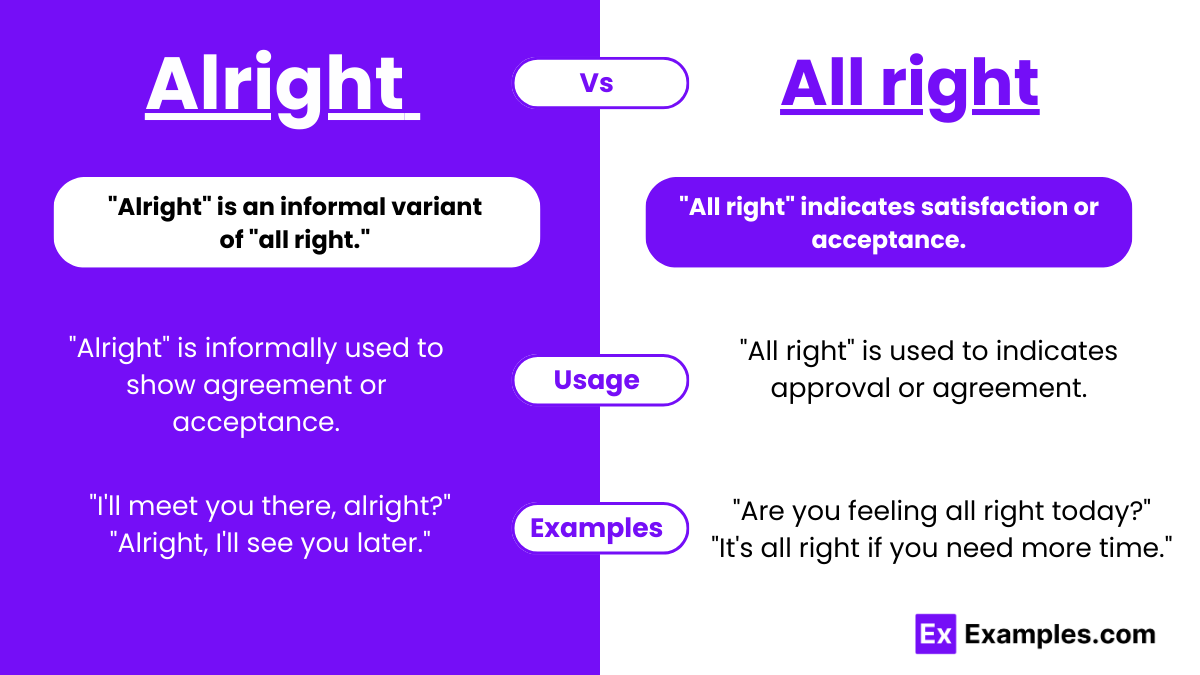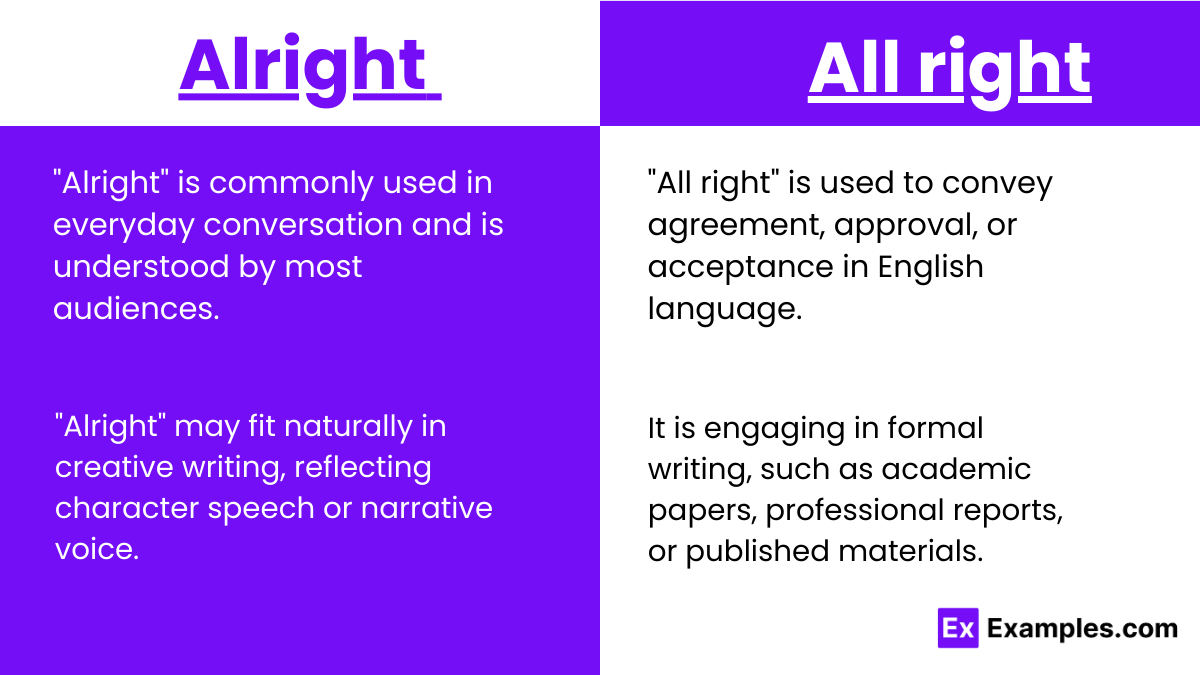Alright vs All right
The English language often brings us face to face with subtle dilemmas, such as the choice between “all right” and “alright.” These two variations, seemingly interchangeable and carrying the connotation of being “okay,” have sparked debates among linguists, writers, and the general populace alike. While “all right” has long been the standard form in published works, its condensed counterpart “alright” has found a robust presence in informal communication and digital discourse. This divergence in usage underscores a broader conversation about language evolution and the acceptance of colloquial forms in formal writing.
The endorsement of both “all right” and “alright” by authoritative dictionaries like Merriam-Webster and the Oxford English Dictionary marks a significant milestone in their linguistic journey. However, this official recognition has not entirely quelled the controversy surrounding their use. The debate is further complicated by cultural references, such as Matthew McConaughey’s iconic catchphrase, which ingrains “all right” in popular lexicon, yet doesn’t necessarily clarify the academic stance on “alright.” As we delve into the comparison of these two forms, we tread on a battleground where traditional grammar rules clash with contemporary usage, revealing much about our ever-evolving language.
Alright and All right – Meanings
Alright: “Alright” is a variant of “all right” that has emerged in informal communication. It carries the same meanings as “all right,” signaling adequacy, agreement, or an affirmative response. Despite its widespread use in everyday language and digital communication, “alright” is often viewed with caution in formal contexts. Some dictionaries and style guides have begun to accept “alright,” recognizing its prevalence, but it remains a contentious choice among traditionalists.
All Right: “All right” is a phrase used to indicate that something is satisfactory, acceptable, or in a satisfactory condition. It can function as an adjective, adverb, or interjection, conveying a sense of being correct, safe, or in good health. In formal writing, “all right” is the preferred form, embodying a range of meanings from agreement (“That’s all right”) to well-being (“I’m all right”).
Summary
The terms “all right” and “alright,” though functioning similarly as adjectives, adverbs, or interjections to convey a sense akin to “okay,” differ in their conventional acceptance and usage. The spaced version, “all right,” is traditionally favored in formal publications, signifying correctness or agreement. Conversely, “alright” enjoys popularity in informal exchanges and has gained recognition in notable dictionaries like Merriam-Webster and the OED, despite its rarity in official texts. This distinction highlights the fluid nature of language and the varying degrees of acceptance for different forms based on the context of their use.
Difference Between Alright and All right
The distinction between “alright” and “all right” might seem subtle, yet it carries significant implications in the realms of English language usage and style. While both terms are used to express a state of being satisfactory, acceptable, or in agreement, their usage varies across different contexts and preferences. “All right” is the traditional form that finds its roots deep in formal writing, adhering to conventional grammatical standards. On the other hand, “alright” emerges as a more modern, albeit controversial, variant that is prevalent in informal communication. This table delves into the nuances that set these two expressions apart, highlighting their characteristics across various dimensions.
| Aspect | All Right | Alright |
|---|---|---|
| Formality | Preferred in formal writing and publications. | Common in informal contexts and everyday communication. |
| Dictionary Acceptance | Recognized by most dictionaries as the standard form. | Included in some dictionaries like Merriam-Webster and OED, but still considered nonstandard by others. |
| Usage in Published Writing | Predominantly used in professional, academic, and published texts. | Less common in published writing, except in quotes or informal styles. |
| Historical Acceptance | Has been considered correct and standard for a longer period. | Viewed as a more modern variant and less traditionally accepted. |
| Perception Among Linguists | Generally accepted by linguists and grammarians. | Debated among language experts, with some accepting it and others advocating against its use. |
| Variety | Seen as the more versatile option for different contexts. | Sometimes seen as limited or less versatile due to its informal nature. |
| Cultural References | Often used in formal speeches and literature. | May appear in pop culture, social media, and casual dialogue. |
| Audience Expectation | Expected in academic, business, and formal settings. | More accepted among younger audiences and casual settings. |
| Style Guides | Endorsed by most style guides for academic and professional writing. | Many style guides advise against its use in formal writing. |
| Evolution | Remains consistent in its traditional usage. | Reflects the evolving nature of language and informal communication trends. |
Understanding the differences between “all right” and “alright” not only aids in choosing the appropriate term based on the context but also offers insight into the dynamic and ever-changing landscape of the English language.
Examples of Alright and All right
Examples of “Alright”
- “I guess it’s alright to go out tonight, as long as we’re back by midnight,” said the cautious teenager.
- She felt alright after taking the medicine, with most of her symptoms alleviated.
- “Are you feeling alright?” he inquired, noticing her quiet demeanor.
- The casual meeting went alright, with everyone contributing their ideas.
- “It’s alright, mistakes happen,” she reassured her teammate, brushing off the error.
Examples of “All Right”
- After the accident, everyone checked to ensure they were all right before leaving the scene.
- The teacher confirmed that all answers on the quiz were all right, marking a perfect score for the student.
- “Is it all right if I borrow your book for the weekend?” she asked her friend.
- The audience applauded, signaling that the performance was all right in their eyes.
- He made sure all the arrangements for the event were all right, leaving no room for errors.
When to Use Alright and All right
Choosing between “alright” and “all right” depends largely on the context of your writing and the audience you are addressing.
Usage of “Alright”
- You are involved in informal writing or communication, such as personal texts, social media posts, or casual dialogue. “Alright” is commonly used in everyday conversation and is understood by most audiences.
- You are writing for a younger or more contemporary audience that is more receptive to modern variations of language.
- The setting is creative or character-driven, such as in fiction or screenwriting, where “alright” might reflect the natural speech patterns of characters or the narrative voice.
Usage of “All Right”
- You are engaging in formal writing, such as academic papers, professional reports, or published materials. This form is widely accepted as the standard by grammarians and style guides.
- You wish to adhere to traditional English usage to ensure clarity and prevent any ambiguity in more conservative or formal settings.
- The context calls for a nuanced expression, where “all” could be emphasized for effect, as in “Are all the answers right?”
Uses of all right and alright
| Part of Speech | Function |
|---|---|
| Adjective | Used to describe a state of being satisfactory, acceptable, or in good condition. When “all right” or “alright” is used as an adjective, it often refers to the overall status or quality of something or someone, suggesting that things are as they should be or that there are no significant problems to report. For example, in the sentence “The performance was all right,” the term assesses the quality of the performance as satisfactory. |
| Adverb | Employed to convey that an action, event, or circumstance has occurred in a satisfactory manner or to a satisfactory degree. As an adverb, “all right” or “alright” modifies verbs, adjectives, or other adverbs, providing a sense of adequacy or sufficiency. For instance, saying “She did all right on her test” implies that the individual’s performance met or exceeded a basic level of acceptability. |
| Interjection | Utilized to express agreement, consent, or acknowledgment, often in response to a question or statement. As an interjection, “all right” or “alright” serves a communicative function in dialogues, signaling the speaker’s acquiescence or understanding. For example, the exclamation “All right, let’s go!” indicates readiness and agreement to proceed with a proposed action |
Tips for Alright and All right
- Consider the Context: Use “all right” for formal writing, such as academic papers, professional documents, and official communications. Opt for “alright” in informal settings like personal messages, casual conversations, and creative writing where a colloquial tone is acceptable.
- Follow the Style Guide: If you’re writing for an organization or publication, adhere to their preferred style guide. Many style guides, especially for academic and professional writing, recommend “all right” over “alright”.
- Audience Expectation: Tailor your choice to your audience’s expectations. “All right” is generally safer in diverse or unknown audiences, as it is universally accepted and understood.
- Regional Preferences: Be aware of regional variations in the acceptance of “alright”. In some English-speaking regions, “alright” is more widely accepted in spoken language.
- Clarity and Precision: If there’s any possibility of ambiguity or misunderstanding with “alright”, default to “all right” for clarity.
- Literary and Creative Works: In creative writing, the choice between “alright” and “all right” can also be influenced by the character’s voice or the setting of your story, where “alright” might be more fitting for certain dialogues or narratives.
- Proofreading: Always proofread your work. If you’re unsure which form to use, “all right” is the safer choice that is less likely to be viewed as an error.
- Stay Informed: Language evolves, and the acceptance of “alright” is increasing in some contexts. Keep abreast of current trends and changes in language usage by consulting updated dictionaries and style guides.
- Educational Materials: For teachers and educators, when teaching the basics of English, it’s advisable to start with “all right” as the standard form, introducing “alright” later as a colloquial variant.
- Be Consistent: Once you choose between “alright” and “all right” in a piece of writing, maintain consistency throughout to ensure coherence and stylistic integrity.
FAQs
When Should We Say Alright?
Use “alright” in casual conversations or informal writing when acknowledging or agreeing with someone. It’s perfect for informal dialogues, texts, and social media, conveying a relaxed tone.
Is It Quite All Right or Alright?
“Quite all right” is the preferred form in formal contexts, emphasizing correctness. “Quite alright” is commonly used in casual conversation, reflecting a more informal tone.
Why Do People Say Alright Now?
Saying “alright now” often serves as a transition, signaling a change in topic or a move to action. It’s a colloquial way to regain attention or refocus a conversation.
Why Do People Say Alright Instead of Hello?
Saying “alright” instead of “hello” is a friendly, informal greeting, common in certain dialects or social groups. It implies familiarity and ease between the speakers.
Is Alright Thanks Rude?
“Alright, thanks” can seem curt or informal, depending on context and tone. In casual settings, it’s usually acceptable, but in formal communication, a more explicit acknowledgment might be preferred





